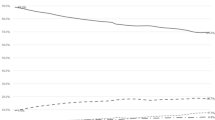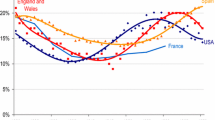Abstract
This paper uses longitudinal Swedish data and investigates the accumulation and persistence of welfare problems over time. The data set was compiled in a first wave in 1979, a second wave in 1986–1987, a third wave in 1994–1995, and a fourth wave in 2002–2003 (N = 7,967). First, the results demonstrate that all welfare problems have a tendency to become persistent. For example, the probability of suffering from the lack of a close friend in the fourth wave was 57.1 % if the individual suffered from this welfare problem in the third wave. Second, economic problems constituted the welfare problem with the most associations with other welfare problems. Third, the accumulation of welfare problems significantly differed between different categories of individuals. For example, the accumulation of welfare problems was higher in men compared with women, immigrants compared with native Swedes, single individuals compared with individuals in couples, and poorly educated individuals compared with highly educated individuals. Finally, longitudinal analyses indicated individuals in certain categories have experienced cumulative disadvantages in welfare even during periods when individuals in other categories have experienced a positive trend in welfare. One such example is single parents during the period between 1979 and 1986–1987.

Similar content being viewed by others
Notes
For an introduction to repeated measures analysis, see Keppel (1991) and the website “Repeated measures analysis with SPSS. UCLA: Statistical Consulting Group”.
References
Bask, M. (2010). Cumulative disadvantage and connections between welfare problems. Social Indicators Research, 103, 443–464.
Bask, M., Ferrer-Wreder, L., Salmela-Aro, K., & Bergman, L. (2014). Pathways to educational attainment in middle adulthood: The role of gender and parental educational expectations in adolescence. In J. Eccles & I. Schoon (Eds.), Gender differences in aspirations and attainment. A life course perspective. Cambridge: Cambridge University Press.
Chartier, M. J., Walker, J. R., & Naimark, B. (2010). Separate and cumulative effects of adverse childhood experiences in predicting adult health and health care utilization. Child Abuse and Neglect, 34, 454–464.
Crystal, S., & Waehrer, K. (1996). Later-life economic inequality in longitudinal perspective. Journal of Gerontology: Social Sciences, 51B, S307–S318.
Erikson, R., & Goldthorpe, J. H. (1992). The constant flux: A study of class mobility in industrial societies. Oxford: Clarendon Press.
Halleröd, B., & Bask, M. (2008). Accumulation of welfare problems in a longitudinal perspective. Social Indicators Research, 88, 311–327.
Halleröd, B., & Westberg, A. (2006). Youth problem: What’s the problem? A longitudinal study of incomes and economic hardship among Swedish youth. Acta Sociologica, 49, 83–102.
Inghe, G. (1960). De fattiga i folkhemmet. Uppsala: Almqvist & Wiksells.
Kennedy, B. P., Kawachi, I., Glass, R., & Prothrow-Stith, D. (1999). Income distribution, socioeconomic status, and self-rated health. In I. Kawachi, B. P. Kennedy, & R. G. Wilkinson (Eds.), The society and population health reader: Income inequality and health. New York: New Press.
Keppel, G. (1991). Design and analysis: A researcher’s handbook (3rd ed.). Englewood Cliffs, NJ: Prentice-Hall.
Neckerman, K. M., & Torche, F. (2007). Inequality: Causes and consequences. Annual Review of Sociology, 33, 335–357.
Radner, D. B. (1987). Incomes of the elderly and nonelderly, 1967–84. Social Security Bulletin, 50, 9–28.
Sadowski, H., Ugarte, B., Kolvin, I., Kaplan, C., & Barnes, J. (1999). Early life family disadvantages and major depression in adulthood. British Journal of Psychiatry, 174, 112–120.
Online resources
OECD (2013). Retrieved November 12, 2014 http://www.oecd-ilibrary.org/social-issues-migration-health/international-migration-outlook-2013_migr_outlook-2013-en
Repeated measures analysis with SPSS. UCLA: Statistical Consulting Group. Retrieved November 12, 2014 http://www.ats.ucla.edu/stat/spss/seminars/Repeated_Measures/
Author information
Authors and Affiliations
Corresponding author
Additional information
This paper has benefited from comments by an anonymous reviewer, Mikael Bask and Björn Halleröd. I am also grateful to the Institute for Research in the Social Sciences (IRiSS) at Stanford University for providing the opportunity to finalize this paper during an extended research visit at IRiSS. The usual disclaimer applies. (Version: November 14th, 2014.).
Rights and permissions
About this article
Cite this article
Bask, M. Accumulation and Persistence of Welfare Problems over Time. Soc Indic Res 125, 757–770 (2016). https://doi.org/10.1007/s11205-015-0868-y
Accepted:
Published:
Issue Date:
DOI: https://doi.org/10.1007/s11205-015-0868-y




